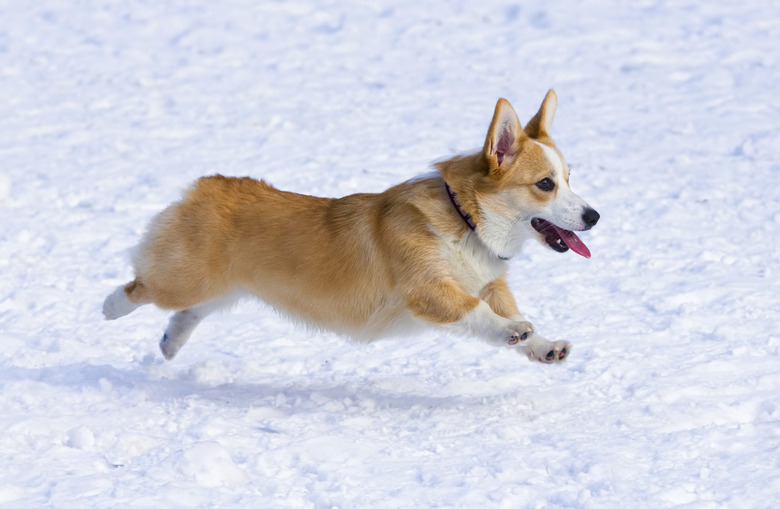What Types Of Dogs Have Short Tails?
Many dogs were bred to assist their human masters to perform functions such as herding livestock, hunting, and protecting property. Tails that might get snagged on bushes or be grabbed by such predators as a pack of wolves were considered a liability in many of these working breeds. Over time, selective breeding succeeded in developing some dogs with short tails naturally. In others, the now-controversial practice of docking the tails of puppies permanently eliminates that inconvenient appendage.
Tails: a tale of genetics
Tails: a tale of genetics
The Pembroke Welsh corgi is a popular low-maintenance small dog — and one that helped scientists unlock the secret to naturally short tails. In 2001, a team of British researchers discovered that the Corgi boasts a short or nonexistent tail because of a genetic anomaly called the "T-box mutation." In a European study published in the October 2008 "Journal of Heredity," 23 breeds in which short tails occur naturally were tested. The same genetic mutation was found in 17, most of them herding and hunting breeds.
Some are rare in North America. Those recognized by the American Kennel Club include the Australian shepherd, Pyrenean shepherd, Polish lowland sheepdog, Australian cattle dog, Spanish water dog, Brittany, Jack Russell terrier, schipperke, and Swedish vallhund. Of six mutation-free breeds, Boston terriers and English bulldogs consistently "all either lack or have very short and kinky tails," the researchers wrote. Although they didn't understand why, they believed another gene must be responsible.
Four breeds in which natural bobtails occasionally occur even when both parents have long tails include the Parson Russell terrier, King Charles spaniel, miniature schnauzer and Rottweiler.
Bobtails: not always natural
Bobtails: not always natural
When purebred dogs who owe their short tails to the T-box mutation produce a litter, not all puppies automatically inherit that characteristic. Genes are linked together in pairs, one copy from each parent. Naturally short or absent tails occur only when the dominant T-box gene is paired with a recessive gene.
Two T-box genes together produce spinal cord birth defects so severe that affected embryos die in utero. However, two recessive genes will produce puppies with naturally longer tails, an undesirable characteristic in bobtailed breeds. Before DNA testing, tail-docking soon after birth used to render this undetectable. Today, inexpensive blood tests can tell breeders whether the bobtailed dogs they're considering using as breeding stock were born that way.
Dog breeds with docked tails
Dog breeds with docked tails
In the United States, as many as 70 breeds of dogs customarily have their tails docked or cropped, including poodles, some mastiffs, pinschers and many breeds of spaniels and terriers. Docking tails purely for appearance has been outlawed or restricted as unnecessarily cruel in many countries, including Australia, the U.K. and many other European nations.
The American Veterinary Medical Association disapproves of the practice on the grounds that it constitutes a painful and unjustified cosmetic surgical procedure, but the American Kennel Club calls it "integral to defining and preserving" the character of some breeds. Defenders of the practice in some herding, hunting and guarding breeds argue that the tail can impair the ability of a dog to do the work for which they were bred.
A successful bobtail breeding experiment
A successful bobtail breeding experiment
One way of satisfying both tail-docking opponents and people who believe some breeds simply look better without anything wagging on their rear ends would be to manipulate tailed breeds for natural bobtails genetically. An experiment conducted by U.K. geneticist and boxer breeder Dr. Bruce Cattanach proved this could be done. In 1992, Cattanach bred one boxer female to a naturally short-tailed Welsh Pembroke corgi male. The union produced a few naturally bobtailed mixed-breed puppies.
Four generations after cross-breeding those dogs with purebred boxers, the only characteristic that distinguished Cattanach's boxers from other purebred examples of the breed was that unlike the others, some of his were born with natural bobtails.
References
- American Veterinary Medical Association: Canine Tail Docking FAQ
- DDC Veterinary Animal DNA Testing: Canine DNA Testing for Natural Bobtail
- Journal of Heredity: Ancestral T-Box Mutation Is Present in Many, but Not All, Short-Tailed Dog Breeds
- American Kennel Club: AKC Statement on AVMA Crop and Dock Policy
- Dogs Monthly: Boxer – Brilliant Boxers!


